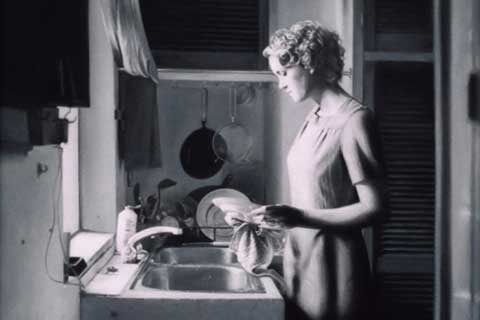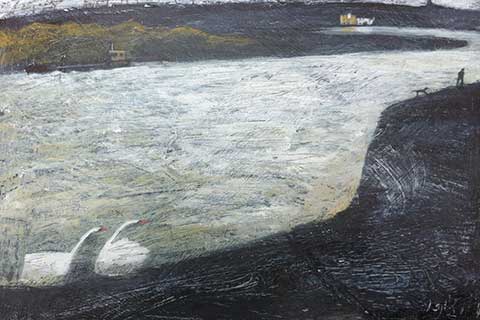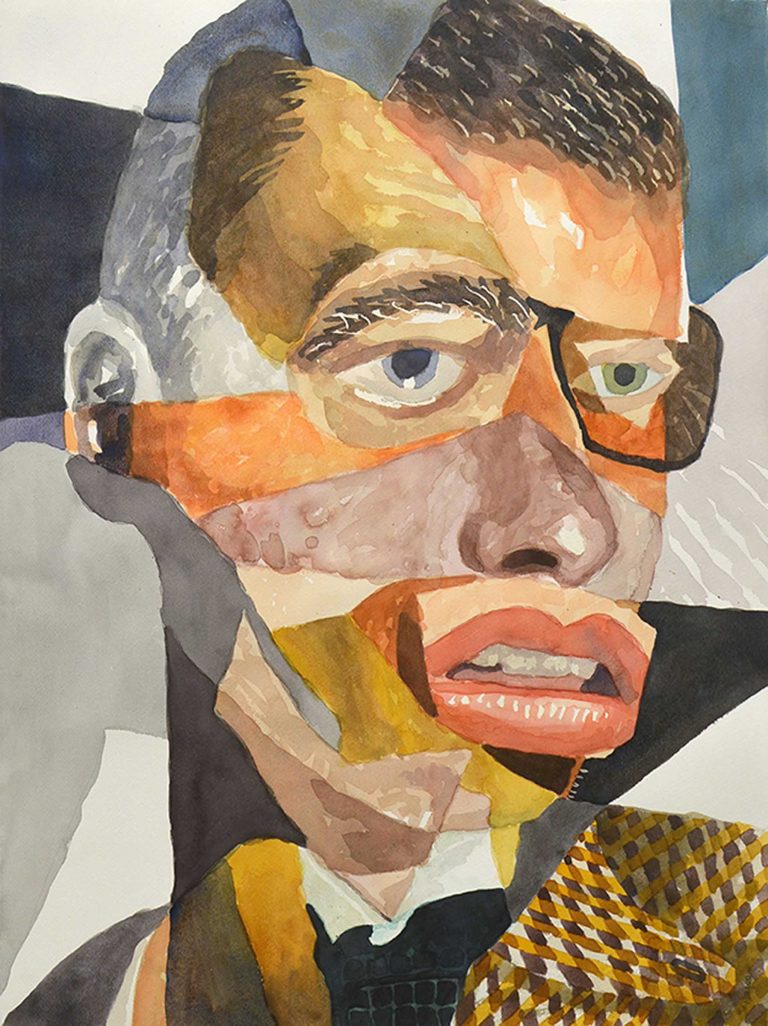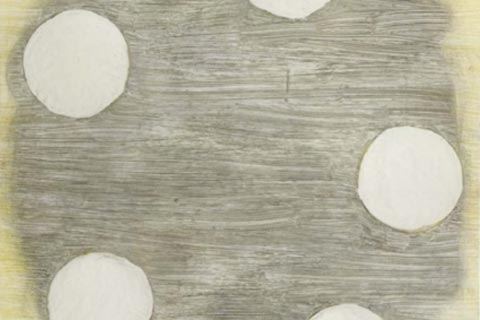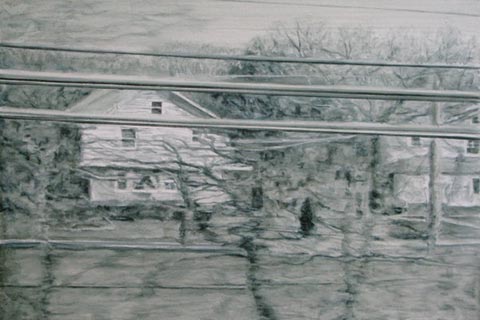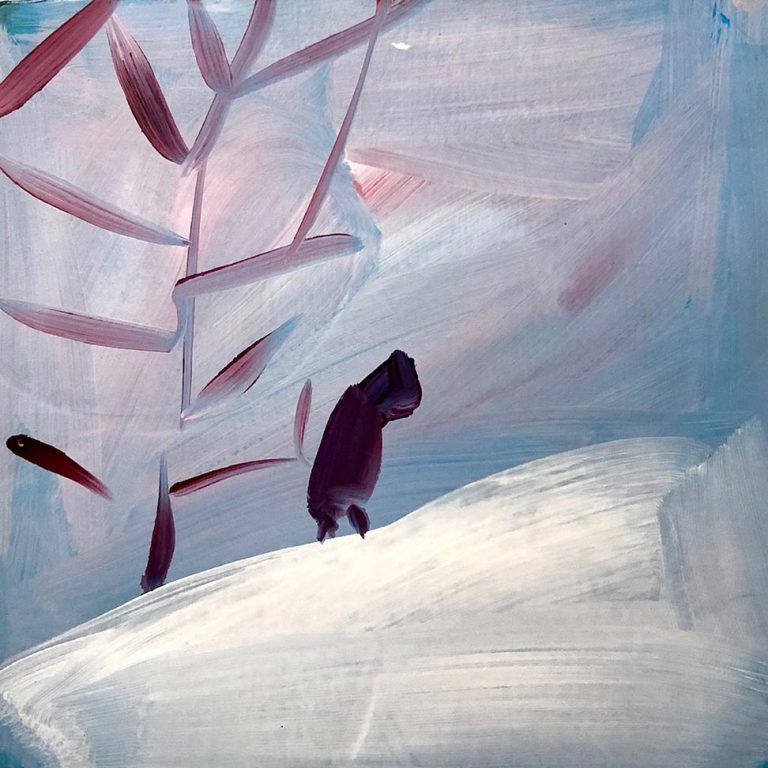Nicholas Middleton in conversation with Barbara Peirson
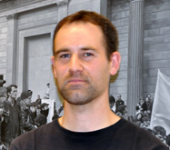
Barbara Peirson: So Nick, I didn’t really know anything about you and your work until I was coming here on the train and I looked you up and so I’m now full of curiosity and maybe a good place to start is at the beginning. It would be great to know how you became a painter…
Nicholas Middleton: I suppose it was part of my family inheritance: my father is an artist, and, growing up, he was a good example of somebody who was always making work, whether it was paintings or prints, and also we used to go to exhibitions quite a lot as children. It never felt like an alien world to me, so it always felt familiar and something which was around, there were books at home to look at, and, as I say, looking at my dad’s work, which was, I suppose, in a sense quite an influence in terms of seeing what was possible.
BP: So from what you’re describing it sounds like it was a very logical way forward. Was there a point at which you made a decision that that was what you were going to do?
NM: I don’t know if I felt I was ever consciously making any decisions. Sometimes it feels like I’ve reached the stage where I’m at, at the moment, by following the path of least resistance: every step along the way has just been doing perhaps the most natural or the easiest thing, so, finishing school, then going to art college, and then when I finished art college I got a job as an artist’s assistant, and then I was making my own work, so it all seemed to flow quite logically from there. I suppose there was never really a point where I felt like I had to sit down and make a decision about what it was I wanted to do.
BP: That seems enviable to me, in some ways…
NM: Although I say that it feels like it was just a logical progression, along that way there’s inevitably the doubts about what it actually is, I do have quite an interest in photography and printmaking as well as painting, and the styles that I’ve used for paintings have changed quite a lot over the course of my career, so you’re always reaching points where, within the boundaries of what you’re doing, you feel like, is this the right thing to be doing? But I suppose I always knew that I wanted to be an artist
BP: Yes, it’s interesting because in your work I see there’s a feeling of certainty about what you’re doing, it feels very sure, and that sort of tallies with what you have described in your way towards it. So I’m curious to know as well, have you always kept those different practices alive and speaking to one another or was there a time you felt you were a photographer or a painter or… ?
NM: Since leaving art college I have always been painting, partly because it’s the discipline which needs the least amount of facilities in any sense. At the most basic you just need a bit of paper, a few brushes and a couple of paints, and you can just do it. With printmaking it’s something I’ve dipped in and out of, I had quite a long period after finishing art college where I didn’t make any prints at all and then only later came back to it. I suppose there are times where it feels I’m more focused on my painting practice without any other distractions, sometimes work in different mediums feels like it’s a distraction from the business of painting.
BP: Oh, That’s interesting…
NM: But at the same time some of those distractions are very useful and they end up feeding back into the paintings I’ve been making paintings, particularly with photography, because pretty much all the paintings I do are based on photographs I take myself with film cameras and I develop the film myself and so I’m sort of in control of the whole process from start to finish, so in a sense having that interest in photography really helps along the way to producing a painting at the end of it
BP: I see, so when you take photographs do you take them… I’ve noticed that some of the paintings you’ve done are paintings that you’ve set up so you set up a photograph, does that mean you’ve envisaged a painting first of all, and then you go and take photographs to go make it? Or how does that… what’s the order that it happens?
NM: Some of them, particularly the larger paintings that I’ve done, have started with an idea for a painting and then I have specifically set that up, so sometimes it’s been finding a figure to model in the picture then photographing the scenario, quite often there’s a transformative process along the way before the actual painting gets done. Some of the larger paintings might be based on a dozen or so photographs which are all worked together and a painting comes out of them. On the other hand, a lot of the smaller paintings are more like snapshots, and many of those come from photographs I didn’t take at the time with the intention of making a painting, it’s just the business of always having a camera with me so anything that catches my eye in terms of composition, lights or darks, anything, I’m able to photograph it and then sometimes there’s a process of weeks, months, or even years, before it almost surfaces from the unconscious and you think “actually, that would make a really nice painting”.
BP: Yes I understand. So when you… so your paintings look like photographs, that’s one of the first impressions isn’t it, that first of all, especially with these ones which look like old postcards at first, that’s a deliberate decision, isn’t it?
NM: I suppose so.
BP: Okay…
NM: When you are in the middle of the process it’s hard to separate out those decisions that go into making a piece… when I started painting after I left college, I didn’t… well, I suppose I fought against the idea of just making a painting from photographic sources which looked like a photograph, so I used lots of strategies to disguise it, or to confuse it in a sense, making paintings which were more like collages, or reducing imagery to… well, I borrowed things from pop art to, I suppose, to complicate things, for a few years it felt like I was fighting against what I seem to be naturally quite good at, and then it reached a point where I just felt I didn’t want to tie myself in too many knots in terms of the thinking which was going on behind the pictures and then just let myself just paint fairly directly from photographic sources.
BP: So was there something that liberated you from that, something that gave you the freedom to go with that?
NM: I don’t know if there was anything specifically that did, I think looking at other artists’ work helped.
BP: Yes, who?
NM: Well it’s probably an obvious choice to say it but Gerhard Richter. There’s a Richter quote where, and I can’t remember it off the top of my head, but he says it was quite a liberating thing to realise that by picking a photographic reference you could just make a painting of anything and it freed him up from having these Late Modernist concerns, coming out of the era of Abstract Expressionism. Again it was just a question of not trying to complicate things too much, I like the way the photographic object looks, and in a sense, not make my paintings look like photographs strictly speaking but just painting from them in quite, well I hoped, in quite an artless way, so without trying to, I don’t know, put in stylistic flourishes or trying to make things too bravura, or too precise. I realise that other people may look at my paintings and just think they look like photographs, but to me they never quite do.
BP: No, they don’t, at first glance they do, but then… I’m really struck by, especially the paintings with faces in at how alive those faces are, much more than they somehow could be on a photograph, somehow there’s breath in them, that’s how it looks to me, and when you talk about Gerhard Richter, I’m also struck just by the edges of shapes you’ve made, and just the quality of the tone, it’s somehow, even though I can see its a real true- or it looks like a true representation of what you’re looking at- still, somehow it has it’s own rules I suppose, it’s the only way I can think of describing it.
NM: I think what I’m quite keen to do with the look of my paintings is create something which draws an audience in, I’m sure some people look at them and think they just may be a photograph, and see that they’re not quite right and want to look into the picture a bit more. And hopefully that’s something which the paintings do. I suppose I’m keen that people appreciate the work on a number of levels, and if on an initial look the work is just appreciated for the technical skill, then in a sense that’s enough, but I’m quite happy for people to look deeper into the work after those surface qualities.
BP: Well, there are so many layers aren’t there? When you were just drawing my attention to the form of the shapes in the picture, but also there’s at the content, then the story behind why you have chosen it, which is… I get the feeling, there’s stories behind all of them in a way.
NM: Well, quite a lot of the subjects I choose do have layers of history, sometimes it might just be personal history, but sometimes it will relate to other aspects of history, so a couple of paintings in this particular exhibition are from Berlin, and there’s lots of layers of history close to the surface there, and that comes through. And then there are other paintings which are related to contemporary events, so in the John Moores a couple of years ago I did a painting based on big a protest relating to the currant financial crisis. So quite often there are, in terms of the subject matter, there’s undercurrents, some more obvious in some paintings than others.
BP: How do you do it? How do you get the photographic image on to the canvas? Or is it a secret?
NM: It’s not a secret. I work in quite a traditional way, I actually work using a grid to transfer the image, so I’ll have a photographic image which I will grid up and then whatever I’m painting on, whether canvas or board, and I’ll draw a grid on there to get the proportions and so on. For the bigger paintings on canvas, it’s usually very straight forward, working from the top left hand corner to the bottom right, more or less, so you’re not smudging the work you’ve already painted. Some of the smaller paintings in terms of the way they are painted are more complicated because they tend to have more layers, they’ll be one layer of just blocking everything in tonally and then more layers over the top to refine that and put the detail in. Particularly when working on smoother surfaces I find the way the paint works it’s best to realise beforehand you can’t get all the detail in the first go, just blocking everything in slightly broad more tonal areas and then working the detail in over the top. I think in terms of the actual way I paint there’s no… I don’t know, it might be false modesty but I don’t feel there’s any special technique or any secret to the way it’s done. Some people do ask about the way I paint, the main thing is probably using watercolour brushes for the small work, but there’s no real secret to the way they are done.
BP: And that’s presumably just trial and error, finding things that work?
NM: Yes, certainly.
BP: I was just thinking about David Hockney’s Secret Knowledge and all of those different ways he describes that people have found in order to capture a true likeness and but it sounds like you’ve found a way of working that just works, and that satisfies you, you haven’t been tempted to, when you said you take the photographs with film and develop them yourself, I just thought first of all, perhaps he must take then digitally and I wonder if he’s got a projector…
NM: I’ve tried working with a projection only once, and found that your hand is always in the way of what you’re actually trying to paint or draw at the time…
BP: Of course…
NM: … and then having that the light of the projection on the surface changes all of the tonal relationships. It’s funny that I’ve actually done a painting of an artist doing a painting with a projection, whereas it’s something I never do myself.
BP: What’s special about this exhibition, or what do you feel about its being here?
NM: One of the things that I wanted to do with this exhibition was to introduce a thematic note to it so, although it’s a solo exhibition, I didn’t just want it to be my paintings of a certain period, or up to a certain date, I’ve called it Provisional Cities, drawing on some themes in my paintings of urban landscapes and highlighting the fact that I feel a lot of contemporary urban life is based around the fact that things are provisional so the built environment that feels quite a sold affair is actually often very temporary and a lot of big infrastructure projects seem to have happened where I’ve been living at the time or around where I’ve been living. Although I don’t think in this exhibition there’s any specific paintings to do with the 2012 Olympics, but…
BP: That is what came to my mind when you were talking just then…
NM: I’ve been living very close to where the main Olympic Park site is and so being used to buildings I’ve known for many years… and then the whole landscape being completely changes. But going further back, I lived closed where the M11 link road in East London was being built and I have made I think just the one painting about that, and I suppose one of the themes is this ephemeral nature of things which seem very solid. In this current exhibition there are a few paintings that have that in their history, there is one painting from Berlin which shows the gap where the Berlin Wall used to be and it’s just an empty bit of scrubland, and that scrubland will only be there for a certain period of time before it gets built over again. So in a roundabout way, what I wanted to do with this exhibition is try to point out some aspects of what happens in my work, it’s not strictly a unifying theme and some of the paintings in this exhibition don’t strictly fit into that theme, but I wanted to point those up with titling the show in the way that I did and also writing a statement relating specifically to that.
BP: So that happens kind of as a process of curation of your own work, is that right? Because do you paint those paintings initially thinking that’s part of that collection or… ?
NM: No, it’s more looking back and thinking about what things have interested me and what’s influenced me and seeing that after the fact. A lot of choices are quite instinctual and are governed by processes that you might only be half aware of and there’s always a process of evaluating your work after you’ve made it. And so, looking back at the work, some of the paintings in this exhibition are three, four, possibly five years old, and thinking that there are these themes that tie them together and you can see that there’s all these different things that I’m interested in that don’t always come to the fore, but I suppose to answer your question a lot of those things aren’t conscious decisions at the time, but looking back you can see that there are concerns which keep going throughout the work.
BP: I see, that’s really interesting… it’s funny, a lot of my questions have been answered in that last answer really, which is to do with the way that you are conscious or instinctual in the approach to what you do and I suppose it’s a always a dialogue between the two.
NM: I feel often you take two steps forward and then one step back every time, so you start making work and the reasons, my reasons, for choosing the imagery I’m working from aren’t necessarily all that clear to me and then you look at the work again and you see things which you might not have been all that aware of at the time and then that can feed back into the next work you… there’s a constant dialogue with your own work as it progresses and so it’s just being aware of seeing the work as a whole as it is evolving, and having a show like this is a way of bringing a number of pieces together and looking a them as a whole.
BP: That’s great, thank you
NM: Thanks, thank you very much.
April 2013



